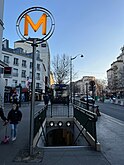|
Gaîté station
Gaîté (French pronunciation: [ɡɛte]) is a station on Line 13 of the Paris Métro in the 14th arrondissement. The station is named after the nearby rue de la Gaîté, which was a country road connecting Clamart with the Barrière du Montparnasse, a gate in the Wall of the Farmers-General at the intersection of the Boulevard Edgar-Quinet and the rue du Montparnasse (the location of Edgar Quinet métro station). It was built between 1784 and 1791 by the Ferme générale, the corporation of tax farmers, to enforce the collection of taxes of goods, including wine, that were imported into Paris. Guinguettes, restaurants, and theatres were built outside the wall to avoid these taxes. "Gaîté" is an old French spelling of "gaiety", reflecting this trade. HistoryThe station opened on 21 January 1937 as part of the initial section of the old line 14 between Porte de Vanves and Bienvenüe (today known as Montparnasse–Bienvenue). On 9 November 1976, the old line 14 was incorporated into line 13 following the latter's extension in successive phases from Saint-Lazare. As part of the "Un métro + beau" programme by the RATP, the station's corridors and platform lighting were renovated and modernised on 15 July 2001.[1] In 2019, the station was used by 2,713,799 passengers, making it the 193rd busiest of the Métro network out of 302 stations.[2] In 2020, the station was used by 1,205,958 passengers amidst the COVID-19 pandemic, making it the 214th busiest of the Métro network out of 304 stations.[3] In 2021, the station was used by 1,644,148 passengers, making it the 216th busiest of the Métro network out of 304 stations.[4] On 30 November 2021, the station was renamed "Gaîté - Joséphine Baker", after Joséphine Baker (1906-1975),[5] an American-born French entertainer and spy during World War II as part of the French resistance, the day she was inducted into the Pantheon. She is the first Black woman to be honoured there, with her body remaining in Monaco.[6][7] This follows the wish of the President for a métro station to be named after her.[8] The station is located next to Bobino, a famous theatre where she held her last performance on 9 April 1975, a few days before her death. Place Joséphine-Baker, located at the end of rue de la Gaîté, was also named after her back in 25 September 2000. It is one of the few métro stations to have been named after a woman, after Bagneux–Lucie Aubrac, Barbara, Barbès–Rochechouart, Boucicaut, Chardon Lagache, Europe, Louise Michel, Madeleine, and Pierre et Marie Curie. On 27 April 2023, two people died at the station after voluntarily going down to the tracks at around 12:45 am. They were hit by an incoming train while attempting to get back onto the platforms.[9][10] This came five days after another accident on the métro at Bel-Air (on line 6) that resulted in the death of a woman when the train departed the platform with her jacket caught between the doors as she was alighting.[11] Passenger servicesAccessThe station has 5 accesses:
Station layout
PlatformsThe station has a standard configuration with 2 tracks surrounded by 2 side platforms. Other connectionsThe station is also served by lines 58, 59, 88, and 92, of the RATP bus network, and at night, by line N63 of the Noctilien bus network. NearbyGallery
Wikimedia Commons has media related to Gaîté (Paris Metro). References
|
|||||||||||||||||||||||||||||||||||||||||||||||||||||||||||||||||||||||||||||
Portal di Ensiklopedia Dunia





